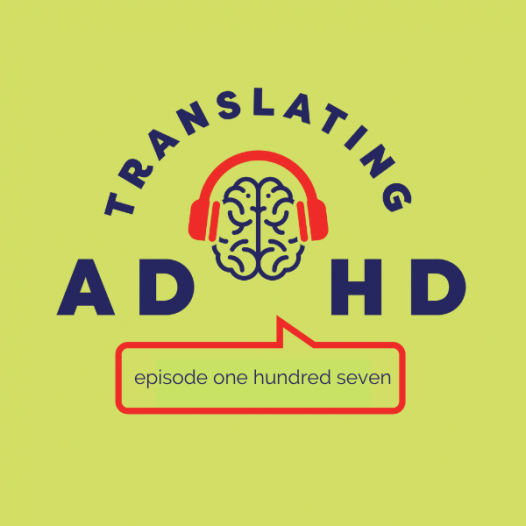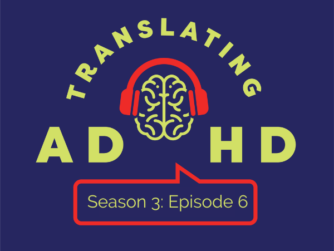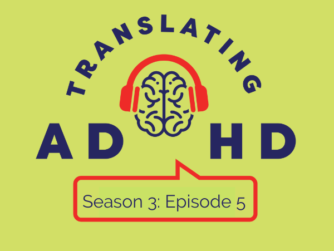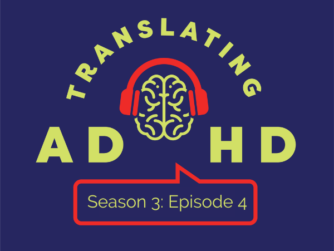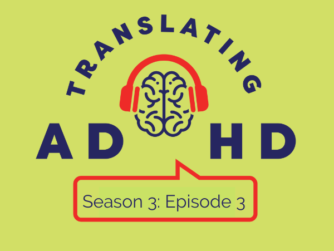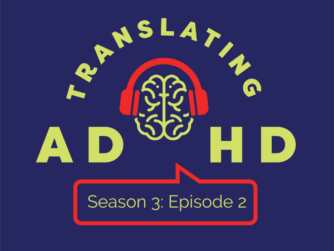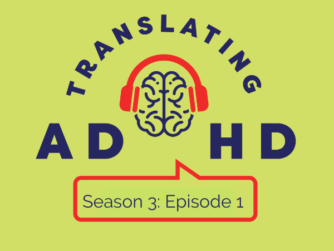Emotions are key to driving beliefs and behaviors. They also play a big part in effective ADHD management. Emotions also drive big signal responses like rejection, sensitivity or imposter syndrome. Those big signal responses can really impact our ability to identify and circumvent First Barrier dilemmas. The First Barrier of ADHD is the barrier to new awareness. Emotions like blame can cloud our judgment, disrupt our own agency and take us offline down some negative emotional rabbit holes (one of our Valley experiences).
Shelly and Cam look closely at blame, one emotion they see often in their new clients, and the habit of ‘blame sponging’ or taking up all of the blame in some circumstance or situation. Emotion rarely operates alone. Black and white thinking and not seeing oneself in the picture contribute to a phenomenon of assuming all of the blame or rejecting it out of hand.
Shelly and Cam share tools well known to long-time Translating ADHD listeners like curiosity and Pause Disrupt Pivot. Distinguishing our own stuff from others’ stuff and determining, through collaboration and communication, the ‘stuff in the middle’ gives us some traction with what once was a very slippery slope.
Episode links + resources:
For more of the Translating ADHD podcast:
- Episode Transcripts: visit TranslatingADHD.com and click on the episode
- Follow us on Twitter: @TranslatingADHD
- Visit the Website: TranslatingADHD.com
Episode Transcript:
Shelly: Hi, I’m Shelly.
Cam: And I’m Cam.
Shelly: And this is translating ADHD. Before we get started this week, just a quick reminder that registration is open for our upcoming coaching group on agency. And there are only a couple of slots left. So if you’re interested in this group, We encourage you to apply. Now that group begins Wednesday, January 19th.
We meet at 8:30 PM Eastern for eight weeks on Wednesdays. For more information, visit the website, translating adhd.com and click on the group coaching tab at the top of the page. So cam on last week’s episode, we briefly mentioned the blame sponge and how that was likely an episode unto itself. And this week, what we’re going to do listeners is we’re not just going to look at the blame sponge, but we’re going to use it as an example to discuss big negative signals that are driven by emotion.
Cam, want to say a little bit more about that and what you and I are noticing in our work with our clients around emotion?
Cam: Yeah. So strong emotions, Big signals generated by emotion. Last week, we were talking about navigating the three barriers, first barrier is the barrier to new awareness. The second barrier is the barrier to new action.
And the third barrier is to new learning and our clients get hung up. Right? We were talking about how our clients come and they often come blocked by that first barrier. They know something’s going on, but they’re not. At that place of recognizing what all is going on. So as we were talking about this, we were realizing, you know, what are the different things that come up that make that wall, that first of all, in particular higher, right?
And so big emotions, right? Big signals that get our attention. So when you have a big signal, And it’s generated by either a positive emotion or negative emotion. But I think today we’re really talking about negative emotions. It can really cloud our ability to see what is going on to get present with the current situation.
So we’ve been talking about this in self-care, the class we’re teaching right now, it’s hard to address the subtle signals of self-care when you’ve got powerful emotions in play. The same thing with our next class around agency, right? Agency is about having choice and control in your day. And yet if you’ve gotten hijacked by some strong negative emotion, it can really turn your day on its head.
And so I think the entry point here is around. Let’s just start with Blake. And how blame can come into play and how it plays out for those of us with ADHD.
Shelly: Yeah. So blame is something that comes up for every one of my clients. We’ve talked before about how our clients arrive to coaching in effect, talking about all of the things they want to be free from. I have this pain, I have these unwanted ADHD behaviors. My life is not working for me and I need help.
Coaching is really a process of creating a life that fits. And so part of our job as coaches is to examine what doesn’t fit for this client. But with ADHD on board, my clients come with this big limiting belief that everything that doesn’t fit is their fault. Do you see that with your clients too?
Cam: Yeah, I can. Everything that doesn’t fit is my fault. Right? So it’s that assumption of blame, but not just assumption of blame it’s it’s assumption of all of the blame, Shelly. And that’s your point there, which is this black and white thinking all or nothing thinking that can occur.
Shelly: exactly, Cam, and it plays out on that global level, but it also plays out for a lot of my clients in smaller ways. In their primary relationships. For example, if their spouse is unhappy, they assume that that’s their fault. They just naturally soak up the blame. That’s why we call it the blame sponge.
Things are contentious at work. A coworker is unhappy with how something turned out. Maybe you were part of an initiative that didn’t pan out again, soaking up all that blame. Know, looking at those negative signals around us, the negative emotions of others and leaping to assumptions that must be about us.
Cam, we talked a few weeks ago on the podcast about a time where you were showing up differently. Because you had some signals that you needed to check in on, and there is a time where rather than asking about that, checking in with you to see what was going on up to and including, is there something going on in this relationship, in this partnership
I would have instead. Quietly been nervous about it. What’s going on with cam, does it have something to do with me? What did I do? What isn’t he telling me? When’s the other shoe going to drop here? When in reality, that situation had nothing to do with me. It had everything to do with you in a circumstance outside of this relationship entirely that was affecting how you were showing up.
But do you see how we can so easily just soak up the blame? I had no context for what was going on for you other than how you were showing up, but there is a time that I just would’ve soaked up the blame for that. Having no idea what it was, but assuming it must be about me and it must be my fault.
Cam: Yeah. So a couple things at work there for those of us with ADHD, right? Is that with our contextual wiring, it’s very difficult for us to see and maintain boundaries. we were talking about this, like what’s mine and what’s not mine. What’s my stuff. What’s not my stuff. This is going back to my own experience in teaching, right.
If the, sort of the they’re onto me, and you talked about it, with a client about the, you know, they’re hatching a plan they’re meeting in the secret room, right? And so this distinction of what’s my stuff, and what’s not my stuff. And as the signal goes up and that narrative is convincing, we assume that it, oh, it must be me. And so then we can see how this plays out into something like RSD responses so much, we kind of blow the limiter off of that emotional management. And this is getting a lot of news right now in ADHD land, this whole emotional regulation.
Shelly: Cam. I’m glad you mentioned that RSD like response because really that’s what’s happening here. It’s easy to see how this is learned behavior. For those of us with ADHD, this doesn’t come from nowhere. This blame sponging. It comes from a lifetime of lived experiences where our ADHD was at. Cause for letting someone down for causing contention for failing to perform.
But the blame sponge doesn’t distinguish the blame sponge does not distinguish between what is our stuff and what is not our stuff. There’s, there’s this learned behavior of avoiding. That shame or guilt or disappointing others that feel so terrible it’s like we’re in this defensive crouch. Poised and ready for any blame that might come our way. And we’re so adverse to that, that we’re like vigilantly, trying to figure out how to not have to face that blame again, even when it might have nothing to do with us, we’re failing to distinguish on so many levels because that big signal just takes over, starts to make a story. And now we can’t see the reality for what it is.
Cam: Yeah. And the place that, we’ve been talking about, listeners, again term that’s out there right now is D E S R deficient emotional self-regulation and so, yes, we struggle with emotional regulation and management. And yet the way Shelly and I see it is here’s a big signal.
Here’s this large emotion, and we’re not adept at really figuring out what to do with it in a proactive way from years and years of adaptive behaviors. You know, Whether you assume all and everything, cause in a way that’s easy. Right then what’s my part, right. there’s work to be done around picking and choosing.
And that’s really hard on an executive function system that is already at a deficit because of this narrative and this big signal, our bandwidth is already depleted and now we need to distinguish my stuff from their stuff and our. It’s hard and yet it’s possible.
Shelly: And this is where. The fact that negative signals are so much stronger than the positive ones comes into play as well. Because again, this maladaptive behavior comes from a lifetime of negative signals in situations where it was our fault. So we get really good at assuming the fault, because guess what we forget.
All of the times where it wasn’t our fault, her all of the times where we had a positive impact in a situation or all of the times that we were being successful in a scenario like this one, our brains don’t go there by default. They go to the negative evidence, the negative storytelling, and we make this leap with no distinguishing.
Just suck it up. The blame cat. Blame sponging is just one of the primary challenges I see with my clients with ADHD and every area of life in their primary relationships, in their familiar relationships, in their businesses or careers. There’s always work to be done in distinguishing. What is really your stuff here?
And what is the stuff you have no control over what lives in the middle, the area where with co-creation and partnership from another person or other people you can affect change, but you can’t do it alone because that is what creates the whole picture of does this relationship. Job scenario, community work as part of a life that fits for me when I start to step back and realize that I alone cannot fully affect change here.
Cam: I want to, I’m going to pull in the other side. side beat. If you will, of this scenario before we get into, what can we do about it for our listeners, right? There’s that sucking up all the blame and then there’s jettisoning, all of the
Shelly: Mm.
Cam: right? This is that the dichotomy of the ADHD experience, right?
It’s that we can fully. Take it all in or fully reject and jettison. So again, it’s back to this big emotion. I’m not sure what to do with, so what do we do in that crouched position? We either, oh, it’s me. Right? It’s all me. It’s all my fault or none of it’s my fault. I see this in my group, coaching with the ADHD partner in the class that I do that follows up Melissa or lofts, couple seminar.
and there’s always a group in there that sort of like relaying the story of we talked about this a couple of weeks ago that sort of the defensiveness and diminishing right to diminish get defensive, download. That is something that happens now. Look at this scenario, someone goes and they get their kid diagnosed. The kid has ADHD, and then you’re sitting in the room and there might be another kid diagnosed with ADHD and it’s like, oh well, there’s a strong genetic predisposition. There’s a strong hereditary component. And you tether back to someone in the. Often a parent it’s like you. You’re to blame, right? So there’s a strong emotion there. And so that levying of the blame number one, that it’s not just, neuro-diverse people that struggle with ownership of blame or being able to break it apart. And see what’s my stuff and what’s their stuff, but on the receiving end of, oh we can do that thing in a defensive posture is pushback denial, That denial part of no it’s what are you talking about? And so, again, it’s this large emotional mushy thing. That’s like, we’ll either take it fully yet. Or we’ll fully, build a wall away from it because it’s too much, Shelly it’s too much because we just like a task is so hard to break into and it’s overwhelming.
A big emotional signal is much the same way that your prefrontal cortex addresses it much in the same way and an inability to. Separate and sift look at the parts and decide, oh, here’s decision-making to what could be mine and what could be someone else’s right. That’s intense executive function effort there.
just, it’s fascinating. You may have been sitting here like, well, I don’t do that. I tend to do something else.
Here’s the other thing. And so what we’re going to offer you though works for both.
Shelly: Cam, what I would like to offer our listeners is what I briefly mentioned a little earlier in this episode. And that is doing distinguishing work as an antidote to this type of behavior. Now let’s be clear in order to do this effectively. You need to be in curiosity. In the pool in your limbic system in the deep ends, you got to find safety first.
Okay. But from that safety place, there’s an opportunity whether it’s at work, whether it’s your primary romantic relationship, whether it’s a friendship. Whether it’s your supervisor, whatever dynamic you have in mind here, where you often feel like your taking on all of the blame for somebody else’s circumstances, or you’re letting all of that blame roll off of you like Teflon, even when it shouldn’t, here’s an opportunity to distinguish.
And when I do this with my clients, I always like to start with what’s your stuff. What is 100% stuff that you and I here in this coaching relationship have the agency and the control to create change on. And then we talk about those things, right? Agency control, right? Being at choice. What are the things that you alone are at choice on and have agency on you don’t need input from others.
It doesn’t necessarily impact others. This is fully 100% your stuff.
Cam: Can I introduce, I’m going to insert a little pre-work to that because. In that situation, that’s important, but they’re in a position to be receptive and open to that. And I just want to go back a few steps to this idea of let’s change the way we think about negative emotion. So Kelly McGonigal does a Ted talk.
She does on the positives of. And so she did a study where they just introduced the idea, just to say that stress is actually good. And that perspective, Shelly, be curious, this is keen observer and be curious about here’s a stressor, this anxiety I’m feeling what I’m worried about. This blame, this strong emotion.
To be curious about that strong emotion. So back to that first barrier of awareness is we are. So in that story or that emotion, that it is running everything, we’ve got to get some perspective first. And so to start with, wait a second, how am I feeling? Where is it in my body? It’s usually some kind of tension to name it and label it.
Number one, I’m feeling. A lot of blame, I’m feeling really responsible here. And how does that feel and what could that emotion be telling us? Just to get a little distance and get some curiosity on it, then start to look at, oh, and then what part? Right. Making this assumption. We don’t own it. All right.
To challenge that narrative uh, oh, must be all my fault. Some of it’s my fault. What part is my fault? What part is my responsibility? Then go into that distinguishing exercise.
Shelly: Thank you cam. And. Backed that up. And really what you talked about there is how to get to safety, how to get enough perspective on this, to be able to then start doing distinguishing work. I want to add to your, how does this feel in the body? Because there are some other ways this might show up for you.
For some of my clients, there’s really powerful language around who they’re being in these moments. I had a client that was a physician who had talked about being the. So the difference between being the intern and being the attending physician, she actually was, I’ve had clients talk about feeling like the teenager versus feeling like a fully autonomous adults, so how does it feel in your body or what role are you taking on is sometimes a helpful way to look at this for my clients.
Cam: and this is your area of identity. And I have a clients like that. Rebellious teenager, right? Little rebel.
Shelly: Yeah. So there are a number of ways to answer that question of how are you feeling and made not be verbal at all. We’ve had a couple of group coaching participants use visuals as a way to further articulate a big emotion, a big signal. So there’s no right or wrong way to answer that. Check-in, what’s true for you.
For me, it’s what is my guts? Or what is my gut telling me? That’s the question I tend to go to, but I’m really strong in the intuitive modality. You may be strong in a different modality. So play around with that and see what brings true for you. Is it a feeling in the body? Is it a role that you can name?
Is it a metaphor or a visual that you can tease apart in articulate? And then as cam said, We can start to distinguish. And we already talked about looking at what is purely my stuff. That’s the question I like to ask first. The question I like to ask next is what is the stuff that is completely outside of your current?
What is the stuff that you have no ability to affect change on. If you’re in a workplace, maybe this just is the way that this is. If it’s interpersonal, maybe your experiences with this person tell you that they are not going to be willing to co-create with you. I have had several clients. Coworker or supervisor situations where we’ve discovered that to be true and having this conversation that even if we could fix all of this stuff, if we could get a hundred percent on the stuff in the, my stuff bucket that ultimately would not change the dynamics that exist because they’re toxic.
And because that other person is not willing to co-create, which brings us to. The third area, which is the stuff that falls in the middle. What is this stuff? I have some ability to affect change on with the buy-in of others. Maybe, work, maybe you need the buy-in of a supervisor or the buy-in of a department, or you need to go through.
Human resources, an advocate for yourself, right? There’s room for advocacy there, or what is the stuff that I need to partner with another person on meaning it’s not just my half of this equation. Maybe there are communication breakdowns, the way, way the communication plays out now between you and another person you can affect change on your house.
But how do you want that other person to show up differently? How can you come together to make this work better for both of you? And here’s a really simple example of that one. I have a client who really struggles with lengthy emails with multiple parts, meaning. Checking on this project and this thing over here, and let’s look four or five steps down the road on this initiative that we’re working on all in one email it’s, it’s overwhelming.
It puts them immediately into a state of feeling like he’s behind feeling like he’s not performing well. And it feels impossible to pick up. And figure out what to do with it. Do I just answer the parts that I can answer now? Do I have to be able to answer this whole thing before I can reply?
Which means there’s an overwhelming amount of work for me ahead. It’s terrible for him. Really simple example of being able to go to that person and articulate his needs, articulate why this type of email doesn’t work for him. And then co-create with that person. So rather than saying, and so coworker, you need to now communicate in the way that works best for me, which nobody is going to respond well to saying, Hey, this doesn’t work well for my brain for these reasons.
Clearly email is a good form of communication for you. So how can we work together on this so that it works for you and I’m not putting undue burden on you, but I’m not having this experience of feeling overwhelmed,
Cam: So I’m sitting here and I’m appreciating this and guess what? Guess what Shelly, because what we’re doing, we’re flipping roles. I’m going to play you.
I’m going to take all that and interpret.
Shelly: Wow.
Cam: Yeah.
Shelly: Wow. That might be a translating ADHD first.
Uh, you interpreting me
Cam: I am. I’m going to interpret you. I’m interpreting you here.
Shelly: perfect.
Cam: Yeah. So listeners, as you’re listening to this, I hope that you’re appreciating, like there’s all these different pieces at your disposal, right? This whole idea of emotional regulation. These terms like DSR, take that with a grain of salt, Yes. You may struggle with regulation, but you know how to distinguish Shelly’s pulling in all these different pieces that we’ve been talking about over the last several episodes, right? The last two years. So this is understand own trends. To go and to speak with someone to distinguish you. Notice that pause, disrupt and pivot would be very helpful here, too, right?
To pause and notice the powerful emotion, how it has a hold on you, what it’s doing and to step back and breathe. The triple 10 ascending as another tool. That’s the ten-second to pause and take 10 seconds to breathe. Step back, consider a way to distinguish the 10% of triple 10 ascending.
Is that maybe 10% of they might be 10%, right? Or 10% vulnerability. How can I enter in here and maybe share, ask. So those of you who have been with us for some time, we invite you to freeform this right, to grab the tool that we’ve introduced and apply it here. It’s going to work for you. And I’m going to add one more that I think would be very helpful in this situation again, when you’re going in and having to discuss. To articulate your situation, how you feel and what are the needs that need to be addressed? The acronym here is beans, like baked beans, black beans. Okay. And just to think about these five terms here, boundaries, am I boundaries getting trampled? Am I putting up a wall? That’s imperfect. Because Shelly, what you’re talking about, there’s this give and take right about tree that is flexible, but also based on values and standards and needs. Expectations is E what are the expectations you remember? We take them and we go up the flag pole often with those expectations are strong emotions. What are their expectations? What are mine? Can we meet in the middle? Can we develop agreements, proactive agreements, they’re going to work here and Shelly, I love that you said, yeah, maybe we can’t come to some agreement and that’s okay. We don’t have to be successful in every dynamic. This is about picking and choosing.
This is going to be central to our agency. You can’t be successful in every relationship in every scenario, that’s black and white thinking and his needs, what are their needs? What are my needs? And finally S is back to the pool and safety to really enter into this with safety and trust, front and center. Trusting that engaging here is going to have some positive outcome. So there’s lots here. This is a big topic, and don’t be satisfied with this idea of emotions are hard. They’re always going to be hard. You can do your work here and be more successful with emotional management and. The next time you do feel that lame sponge or that defensiveness to take a breath and just be with it for them.
Shelly: I love that you said. You cannot be successful in every relationship or scenario that is all or nothing thinking. And it is, but it’s so often what we strive for is ADHD people. So listeners, this distinguishing work, guess what it does for my clients. It puts them at choice. It puts them at choice because now we’re looking at again, I asked that question, looking at just the stuff in the year stuff bucket.
If we can hit a hundred percent there, what does that do for this scenario, this situation, or this dynamic, and then looking at the other stuff. What’s the opportunity there or not to co-create or to have agency to affect change, and then put those two things together. And guess what? My clients now have a much clearer picture of how to move forward. Can this be part of a life that fits or not, and that’s the thing we’re often missing. So yes, you can’t be successful in every relationship or scenario, but taking the time to distinguish puts you at choice, you’re no longer sponging up or teff lining off. All of the negativity in hopes that it will somehow be different tomorrow or next week you are now.
We’re in hopes that the other person might show up differently or that things might change at work. You’re now in the driver’s seat of your own life being a choice. Here’s the reality of the situation. Here’s what I I know I can change on my own. Here’s what I think I can change with some help.
Some partnering, some co-creation here’s what just is now, what does that mean? That’s agency, that’s being at choice. So listeners, if you like what we’re doing here on the show, three ways you can help us out. You know them you’ve heard them before, but we’re going to repeat them again. First is to share us with others, share us with the other neurodivergents in your life.
Post us on social. Don’t keep us a secret. Our listenership is 100% word of mouth, and we love that number to leave a rating or review wherever you listen, this does help other people find the show and it lets people know how and why we are different than the other content out there on ADHD. And finally, you can support us financially by becoming a patron, which pays for all of the costs of running this show, including our editing and our assistant.
To do that, visit the website, translating adhd.com. Click on the Patreon link in the upper right-hand corner. And for five bucks a month, not only are you helping us keep the show going by covering our costs. You also gain access to our discord community, where our listeners are working together to do their own understand, own and translate work.
So until next week, I’m Shelly
Cam: And I’m Cam.
Shelly: and this was translating ADHD. Thanks for listening.

